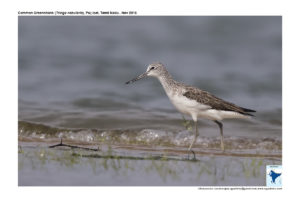Green Shank

Common Greenshank Tringa nebularia
Etymology:
- Tringa : Greek word for trungasthrush-sized, white-rumped wading bird that bobs its tail, mentioned by Aristotle
- Nebularia : Latin word for “mist”
Vernacular Names :Hindi: Tantana, Timtimabatan, Sans: Haritpadjalrank, Pun: Hara chaha, Ben: Gotra, Guj: Lilapug, Timtima, Lilapag, Motililapagthuthvari, Mar: Timbla, SamanyaHirvaTilawa/ tutvaar, Haritsurma, Hirvabataan, Ta: Adiyaen, Periakottan, Mal: Pachakkali, Sinh: Mahawatuwa
Distribution in India:Widespread Winter visitor in India.
Description: Size of 30-35 cm.It is the largest of Tringa species , with long and robust, slightly uptilted bill and dull green legs; upperparts spotted and streaked black-brown, lesser wing-coverts browner; head, neck and upper breast streaked brown-black; in flight, shows dark wings, white back and rump. The female averages slightly larger. Non-breeding adult has feathers of upperparts rather uniform grey, without dark markings; breast, foreneck and face white; stronger contrasting dark wing-coverts.
Habitat: It is found in forest clearings, woody moorland or open bogs and marshes, including blanket bog; characteristic of northern and middle taiga. It breeds up to 1200 m. In migration, found at inland flooded meadows, dried-up lakes, sandbars and marshes. It winters in variety of freshwater and marine wetlands, including estuaries, sandy or muddy coastal flats, saltmarshes, mangroves, swamps and lakes; also on artificial wetlands, such as sewage farms, dam lakes, salt works and inundated rice crops.
Food Habits: It eats insects and their larvae, especially beetles, crustaceans, annelids, molluscs, amphibians and small fish. It usually pecks and probes in shallow water walking with steady pass, sometimes running with erratic changes of direction. When feeding on fish may forage socially in dense flocks of conspecifics or mixed with other tringines, moving erratically while pecking at prey or running synchronously in one direction, ploughing or scything bill through water, and using dash-and-lunge technique to seize larger fish. It feeds singly or in small to large flocks of up to 100 s. It feeds diurnally and nocturnally.
Breeding Habits: They breed in April-Jun in North West Europe.They are monogamous (espl. the female), male exhibits polygamy. The nest is a shallow scrape created by male, lined with some plant material and a few feathers, on ground in open, typically placed next to piece of dead wood, rock, log or tussock. They lay a clutch of 3–5 eggs, with laying interval of 30–72 hours. The incubation period is 22–26 days. Incubation is done by both sexes, but mainly female and males with two mates normally do little incubation, starting with final egg.One parent (typically female) leaves brood before fledging; fledging period is 25–31 days.